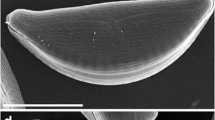Abstract
Fourteen taxa of the Triticum-Aegilops group have been investigated for their sieve-element plastids. At maturity they contain dense and thin crystalloid inclusions and are classified into the PIIc' plastid type; onlyAe. comosa var.biaristata lacked the thin crystalloids and thus conforms to the PII c type. The proteinaceous nature of the crystalloids was demonstrated by application of proteolytic enzymes. Ultrastructural evidence suggests that both kinds of crystalloid inclusions are involved in the sealing of sieve-plate pores of injured sieve tubes. Measurements and calculations of the spacings and angles carried out on crystalloid prints permitted the construction of a two- and three-dimensional pattern forT. aestivum thin crystalloids.
Similar content being viewed by others
References
Behnke, H.-D., 1971: Sieve-tube plastids ofMagnoliidae andRanunculidae in relation to systematics. — Taxon20, 723–730.
—, 1972: Sieve-tube plastids in relation to angiosperm systematics. An attempt towards a classification by ultrastructural analysis. — Bot. Rev.38, 155–197.
—, 1975: P-type sieve-element plastids: A correlative ultrastructural and ultrahistochemical study on the diversity and uniformity of a new reliable character in seed plant systematics. — Protoplasma83, 91–101.
—, 1977: Transmission electron microscopy and systematics of flowering plants. — Pl. Syst. Evol., Suppl.1, 155–178.
—, 1981a: Sieve-element characters. — Nord. J. Bot.1, 381–400.
—, 1981b: Siebelement-Plastiden, Phloem-Protein und Evolution der Blütenpflanzen: II. Monokotyledonen. — Ber. Deutsch. Bot. Ges.94, 647–662.
—, 1983: Sieve-element plastids ofCaryophyllales: additional investigations with special reference to theCaryophyllaceae andMolluginaceae. — Pl. Syst. Evol.142, 109–115.
Eleftheriou, E. P., Tsekos, I., 1982: Development of protophloem in roots ofAegilops comosa var.thessalica. II. Sieve-element differentiation. — Protoplasma113, 221–233.
Esau, K., Gill, R. H., 1973: Correlations in differentiation of prophloem sieve elements ofAllium cepa root. — J. Ultrastruct. Res.44, 310–328.
Eschrich, W., 1975: Sealing systems in phloem. — InZimmermann, M. H., Milburn, J. A. (Eds.): Transport in Plants I., Phloem Transport. — Encyclopedia of Plant Physiology (N. S.),1. — Berlin, Heidelberg, New York: Springer Verlag.
Hoefert, L. L., Esau, K., 1975: Plastid inclusions in epidermal cells ofBeta. — Amer. J. Bot.62, 36–40.
Karataglis, S. S., 1975: Karyotype analysis on some diploid native greekAegilops species. — Caryologia28, 99–110.
Karnovsky, M. J., 1965: A formaldehyde-glutaraldehyde fixation of high osmolarity for use in electron microscopy. — J. Cell Biol.27, 137A-138A.
Kimber, G., 1974: A reassessment of the origin of the polyploid wheats. — Genetics78, 487–492.
Lee, R. E., Thompson, A., 1973: The stromacentre of plastids ofKalanchoe pinnata Persoon. — J. Ultrastruct. Res.42, 451–456.
Melaragno, J. E., Walsh, M. A., 1976: Ultrastructural features of developing sieve elements inLemna minor L. — The protoplast. — Amer. J. Bot.63, 1145–1157.
Newcomb, E. H., 1967: Fine structure of protein-storing plastids in bean root tips. — J. Cell Biol.33, 143–163.
Peel, A. J., 1974: Transport of Nutrients in Plants. — John Wiley and Sons.
Renaudin, S., Cheguillaume, N., 1977: On the localization, the fine structure, and the chemical composition of crystalline inclusions in theThesium humifusum haustoria. — Protoplasma93, 223–229.
Reynolds, R. S., 1963: The use of lead citrate at high pH as an electron-opaque stain in electron microscopy. — J. Cell Biol.17, 208–213.
Sasahara, T., 1982: Influence of genome on leaf anatomy ofTriticum andAegilops. — Ann. Bot.50, 491–497.
Simpson, D. J., Baqar, M. R., Lee, T. H., 1975: Ultrastructure and carotenoid composition of chromoplasts of the sepals ofStrelitzia reginae Aiton during floral development. — Ann. Bot.39, 175–183.
Singh, A. P., 1980: On the ultrastructure and differentiation of the phloem in sugarcane leaves. — Cytologia45, 1–31.
Spurr, A. R., 1969: A low viscosity epoxy resin embedding medium for electron microscopy. — J. Ultrastruct. Res.26, 31–43.
Walsh, M. A., Evert, R. F., 1975: Ultrastructure of metaphloem sieve elements inZea mays. — Protoplasma83, 365–388.
—, 1981: Structural evidence for plastid inclusions as a possible “sealing” mechanism in the phloem of monocotyledons. — J. Exp. Bot.32, 311–320.
Wrischer, M., 1967: Kristalloide im Plastidenstroma. I. Elektronenmikroskopisch-cytochemische Untersuchungen. — Planta75, 309–318.
—, 1973: Protein crystalloids in the stroma of bean plastids. Protoplasma77, 141–150.
Author information
Authors and Affiliations
Rights and permissions
About this article
Cite this article
Eleftheriou, E.P. Sieve-element plastids ofTriticum andAegilops (Poaceae). Pl Syst Evol 145, 119–133 (1984). https://doi.org/10.1007/BF00984035
Received:
Issue Date:
DOI: https://doi.org/10.1007/BF00984035




